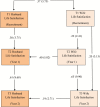Reciprocal Effects of Life Satisfaction and Depressive Symptoms Within Long-Wed Couples Over Time
- PMID: 26869547
- PMCID: PMC5927119
- DOI: 10.1093/geronb/gbv162
Reciprocal Effects of Life Satisfaction and Depressive Symptoms Within Long-Wed Couples Over Time
Abstract
Objectives: This study was undertaken to examine bidirectional effects of well-being over time in long-wed couples.
Method: We recruited 125 couples 50+ years of age who had been married 20+ years. Both spouses reported life satisfaction and depressive symptoms independently at three annual points over 2 years. We computed actor-partner interdependence models (APIMs) to identify concomitant and longitudinal bidirectional effects between long-wed spouses. Where parallel associations were found between models of life satisfaction and depressive symptoms, we undertook invariance analyses to compare the relative strength of associations.
Results: We observed a significant association between wives' and their husbands' life satisfaction at baseline; a concomitant crossover effect was also evident from wives to husbands at 1- and 2-year follow-up, such that wives' life satisfaction predicted changes in their husbands' life satisfaction beyond that previously and concomitantly reported.
Discussion: Our findings suggest that older wives influence their husbands after decades of marriage; the relative effect of this crossover on older husbands is comparatively equivalent for life satisfaction and depressive symptoms. These findings stand in contrast to prior research with younger couples suggesting that long-wed couples may be a distinct subset of the population of all married couples (i.e., those who have not divorced).
Figures


Similar articles
-
Marriage work in older couples: Disclosure of marital problems to spouses and friends over time.J Fam Psychol. 2015 Oct;29(5):732-43. doi: 10.1037/fam0000099. Epub 2015 Jun 1. J Fam Psychol. 2015. PMID: 26030028
-
Reciprocal effects of depressive symptoms and life satisfaction among Chinese older married couples from 2010 to 2014: evidence from the China Family Panel Studies.Aging Ment Health. 2020 Aug;24(8):1216-1224. doi: 10.1080/13607863.2019.1584876. Epub 2019 Mar 8. Aging Ment Health. 2020. PMID: 30845822
-
Alcohol use, alcohol problems, and depressive symptomatology among newly married couples.Drug Alcohol Depend. 2006 Jul 27;83(3):185-92. doi: 10.1016/j.drugalcdep.2005.10.017. Epub 2005 Dec 7. Drug Alcohol Depend. 2006. PMID: 16337752 Free PMC article.
-
Relationship Quality with Parents: Implications for Own and Partner Well-Being in Middle-Aged Couples.Fam Process. 2018 Mar;57(1):253-268. doi: 10.1111/famp.12275. Epub 2016 Dec 22. Fam Process. 2018. PMID: 28004851 Free PMC article.
-
Reciprocal Effects of Marital Idealization and Marital Satisfaction Between Long-Wed Spouses Over Time.Int J Aging Hum Dev. 2022 Dec;95(4):440-454. doi: 10.1177/00914150221077953. Epub 2022 Feb 28. Int J Aging Hum Dev. 2022. PMID: 35224996
Cited by
-
Longitudinal Dyadic Associations between Depressive Symptoms and Life Satisfaction among Chinese Married Couples and the Moderating Effect of Within-Dyad Age Discrepancy.Int J Environ Res Public Health. 2022 Oct 14;19(20):13277. doi: 10.3390/ijerph192013277. Int J Environ Res Public Health. 2022. PMID: 36293854 Free PMC article.
-
Life satisfaction and inflammation in couples: an actor-partner analysis.J Behav Med. 2018 Feb;41(1):22-30. doi: 10.1007/s10865-017-9880-9. Epub 2017 Sep 7. J Behav Med. 2018. PMID: 28884245 Free PMC article.
References
-
- Antonucci T. C., & Akiyama H (1987). An examination of sex differences in social support among older men and women. Sex Roles, 17, 737–749. doi:10.1007/BF00287685
-
- Bair D. (2007). Calling it quits: Late life divorce and starting over. New York, NY: Random House.
-
- Byrne B. M. (2004). Testing for multigroup invariance using AMOS Graphics: A road less traveled. Structural Equation Modeling, 11, 272–300. doi:10.1207/s15328007sem1102_8
-
- Carrere S., & Gottman J. M (1999). Predicting the future of marriages. In Hetherington E. M.(Ed.) Coping with divorce, single parenting, and remarriage: A risk and resiliency perspective (pp. 3–22). New York, NY: Psychology Press.
Publication types
MeSH terms
Grants and funding
LinkOut - more resources
Full Text Sources
Other Literature Sources
Medical

